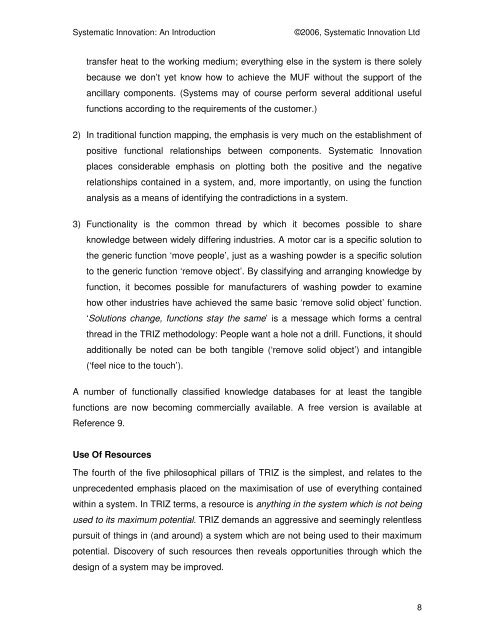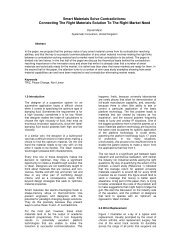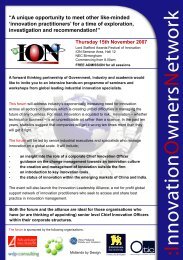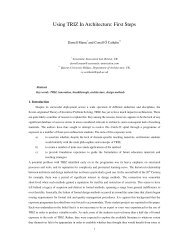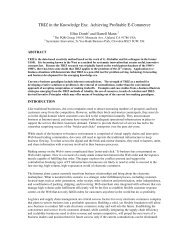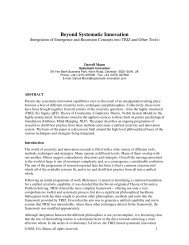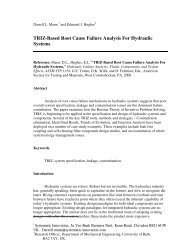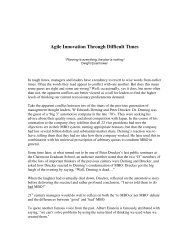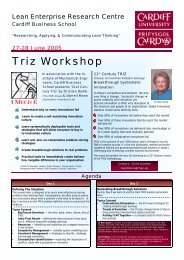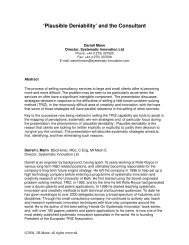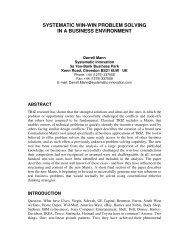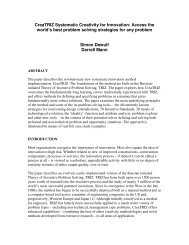Systematic Innovation: An Introduction - Systematic Innovation, TRIZ
Systematic Innovation: An Introduction - Systematic Innovation, TRIZ
Systematic Innovation: An Introduction - Systematic Innovation, TRIZ
You also want an ePaper? Increase the reach of your titles
YUMPU automatically turns print PDFs into web optimized ePapers that Google loves.
<strong>Systematic</strong> <strong>Innovation</strong>: <strong>An</strong> <strong>Introduction</strong><br />
©2006, <strong>Systematic</strong> <strong>Innovation</strong> Ltd<br />
transfer heat to the working medium; everything else in the system is there solely<br />
because we don’t yet know how to achieve the MUF without the support of the<br />
ancillary components. (Systems may of course perform several additional useful<br />
functions according to the requirements of the customer.)<br />
2) In traditional function mapping, the emphasis is very much on the establishment of<br />
positive functional relationships between components. <strong>Systematic</strong> <strong>Innovation</strong><br />
places considerable emphasis on plotting both the positive and the negative<br />
relationships contained in a system, and, more importantly, on using the function<br />
analysis as a means of identifying the contradictions in a system.<br />
3) Functionality is the common thread by which it becomes possible to share<br />
knowledge between widely differing industries. A motor car is a specific solution to<br />
the generic function ‘move people’, just as a washing powder is a specific solution<br />
to the generic function ‘remove object’. By classifying and arranging knowledge by<br />
function, it becomes possible for manufacturers of washing powder to examine<br />
how other industries have achieved the same basic ‘remove solid object’ function.<br />
‘Solutions change, functions stay the same’ is a message which forms a central<br />
thread in the <strong>TRIZ</strong> methodology: People want a hole not a drill. Functions, it should<br />
additionally be noted can be both tangible (‘remove solid object’) and intangible<br />
(‘feel nice to the touch’).<br />
A number of functionally classified knowledge databases for at least the tangible<br />
functions are now becoming commercially available. A free version is available at<br />
Reference 9.<br />
Use Of Resources<br />
The fourth of the five philosophical pillars of <strong>TRIZ</strong> is the simplest, and relates to the<br />
unprecedented emphasis placed on the maximisation of use of everything contained<br />
within a system. In <strong>TRIZ</strong> terms, a resource is anything in the system which is not being<br />
used to its maximum potential. <strong>TRIZ</strong> demands an aggressive and seemingly relentless<br />
pursuit of things in (and around) a system which are not being used to their maximum<br />
potential. Discovery of such resources then reveals opportunities through which the<br />
design of a system may be improved.<br />
8


